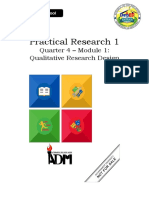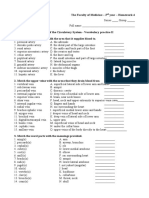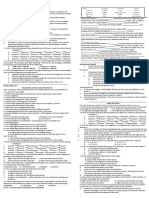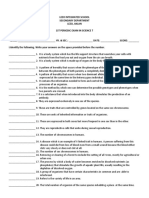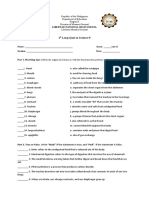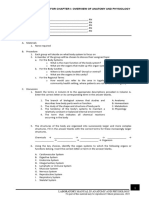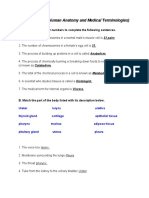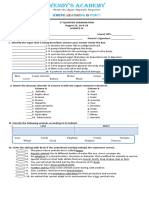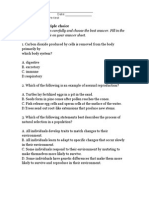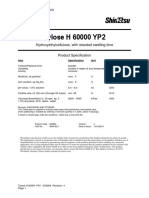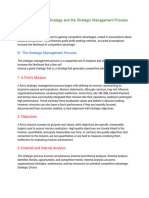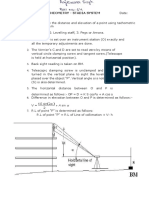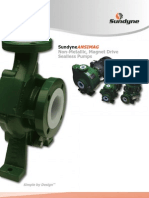1st P.Exam SCIENCE 9
1st P.Exam SCIENCE 9
Uploaded by
Niel CerezaCopyright:
Available Formats
1st P.Exam SCIENCE 9
1st P.Exam SCIENCE 9
Uploaded by
Niel CerezaCopyright
Available Formats
Share this document
Did you find this document useful?
Is this content inappropriate?
Copyright:
Available Formats
1st P.Exam SCIENCE 9
1st P.Exam SCIENCE 9
Uploaded by
Niel CerezaCopyright:
Available Formats
NAZARENUS COLLEGE AND HOSPITAL FOUNDATION, INC.
Score:
Pre–School, Elementary, Junior High School & Senior High School Education
FIRST PERIODICAL EXAM
GRADE 9 – SCIENCE
Name: _____________________________________ Grade & Section: _______________ Teacher: Mr.Reyniel S.Cereza
I. IDENTIFICATION: Identify the answers based on the description / definitions. (1 pt. each).
____________1. The biggest artery and the first site that receives the highest pressure due to the contraction of the left ventricle.
____________2. A dome-shaped muscle that separates the chest from the abdomen.
____________3. A white blood cell that is non-granular leukocyte and is responsible for viral infection and adaptive immunity.
____________4.During this process the rib cage expands and rib muscles contract.
____________5. The case that protects the lungs.
____________6.The fluid component of the blood and is composed of water, proteins and other solutes.
____________7. The powerhouse of the circulatory system.
____________8.A grapelike structures at the tip of each bronchioles and the actual site of gas exchange in the lungs.
____________9.During this process the rib cage gets smaller as rib muscles relax.
____________10.It is found in veins that prevents the backflow of blood within the vessels.
II. True or False: Write TRUE if the statement is correct and write FALSE if the statement is incorrect. (1 pt. each)
____________1.Social extinction happens when a species disappears from our collective memory and cultural knowledge.
____________2.The dinosaurs went extinct in the Cretaceous-Paleogene extinction that happened about 66 million years ago.
____________3.The enamel is considered as the hardest tissue in our bodies and is mostly made of mineral called hydroxyapatite.
____________4.Although bamboo plants are treelike in appearance, they are considered grasses.
____________5.A combination of phosphorus and hydrogen, phosphine, is a gas that can be produced by volcanic activity.
____________6.Codominance is a pattern of inheritance established by Australian monk Gregor Mendel.
____________7. Habitat is consisting of a community of organisms together with their physical environment.
____________8. Blood types are based on the presence or lack of antibodies, which are molecules that can provoke immunological response.
____________9. The six most common elements found in living things on earth are carbon,nitrogen,oxygen,phosphorus,sulfur and helium.
____________10.Brain shrinkage was indirectly proportional to the amount of alcohol consumed.
III. MATCHING TYPE: Match Column A with Column B. Write the CAPITAL LETTER of your answer on the space provided.
(1 pt. each)
A B
____________1.gas exchange between blood and cells A.voicebox
____________2.pharynx is also known as B.petroleum
____________3.entry point of the air to the lungs C.nostrils or nares
____________4.gas exchange between alveoli of the lungs and blood D.windpipe
____________5.abundance of algae E.sternum
____________6.trachea is also known as F.throat
____________7.holes in your nose G.algal bloom
____________8.bone found on the chest at the center H.external respiration
____________9.it is also known as oil I.bronchi
____________10.larynx is also known as J.internal respiration
V. Classify the following parts according to the body system that they belong to. Write capital R for respiratory system or capital C for
circulatory system.
___________1.alveoli __________5.larynx _________9.veins
___________2.arteries __________6.lungs _________10.white blood cell
___________3.blood __________7.paltelets
___________4.capillaries __________8.pleura
VI. ENUMERATION:
1-5 Blood flow in closed circulatory System
6-10 Factors That Threaten Biodiversity
11-15 Renewable Resources
16-20 Blood Flow in open Circulatory System
21-25 Examples of Non-renewable Resources
VIII. PROBLEM SOLVING 5pts. each
In pea plants, tall (T) plants are dominant over short (t) plants. Complete the following crosses and Give the Genotypic and Phenotypic
ratio of offspring:
a. TT x tt
Genotypic ratio:
Phenotypic ratio:
b. Tt x tt
Genotypic ratio:
Phenotypic ratio:
c. Tt x Tt
Genotypic ratio:
Phenotypic ratio:
VII. ESSAY: 5pts. each
1. Why is left ventricle thicker than the right ventricle?
2. What is the difference between Circulatory System and Respiratory System?
You might also like
- Practical Research 1: Quarter 4 - Module 1: Qualitative Research DesignDocument23 pagesPractical Research 1: Quarter 4 - Module 1: Qualitative Research DesignAster Jade80% (5)
- Quiz 2 CirculatoryDocument3 pagesQuiz 2 Circulatorymariarizza.llorente29No ratings yet
- New Res-Circ-WorkbookDocument10 pagesNew Res-Circ-WorkbookHelma Jabello AriolaNo ratings yet
- MG II - TEMA 3 Limba EnglezaDocument3 pagesMG II - TEMA 3 Limba EnglezaGabriel IlinoiuNo ratings yet
- Worksheet 1Document12 pagesWorksheet 1Jessabelle RamosNo ratings yet
- Lesson 1 - Module 1 - Circulatory SystemDocument27 pagesLesson 1 - Module 1 - Circulatory SystemPapiNo ratings yet
- Circulatory System Packet BDocument5 pagesCirculatory System Packet BLouise SalvadorNo ratings yet
- Circulatory System Packet BDocument5 pagesCirculatory System Packet BLouise SalvadorNo ratings yet
- English Homework 4Document2 pagesEnglish Homework 4Teodora TanaseNo ratings yet
- MG II - TEMA 4 Limba EnglezaDocument3 pagesMG II - TEMA 4 Limba EnglezaGabriel IlinoiuNo ratings yet
- Summative Test 1 Sci9Document3 pagesSummative Test 1 Sci9Marian Anion-GauranoNo ratings yet
- 1st PT - Science IXDocument8 pages1st PT - Science IXJhim BHoy Placencia EdnocserNo ratings yet
- AnhDocument15 pagesAnhduyanh4583No ratings yet
- Summative Test Lesson 1Document1 pageSummative Test Lesson 1Pedro GenosasNo ratings yet
- First Periodic Test in Science VIDocument3 pagesFirst Periodic Test in Science VIMaan Bautista100% (1)
- Bio Circulatory System WorksheetsDocument21 pagesBio Circulatory System WorksheetsCraft City0% (1)
- Grade 9-Summative AssessmentDocument2 pagesGrade 9-Summative AssessmentMaryjoy Piosca MolaNo ratings yet
- Animal Systems Review 202401Document10 pagesAnimal Systems Review 202401NoelleNo ratings yet
- Quarter Exam in Science 9Document3 pagesQuarter Exam in Science 9romeespantoNo ratings yet
- 1st Periodic Exam in Science 9Document7 pages1st Periodic Exam in Science 9shirley cortezNo ratings yet
- Science 6 - 3RD Periodical ExamDocument4 pagesScience 6 - 3RD Periodical ExamSheree EguiaNo ratings yet
- Learning Activity Worksheet Science 9 Q1 Weeks 1 2Document7 pagesLearning Activity Worksheet Science 9 Q1 Weeks 1 2ar0411No ratings yet
- UNIT I - Chapter 1 - 20230915 - 125311 - 0000Document6 pagesUNIT I - Chapter 1 - 20230915 - 125311 - 0000VanessaNo ratings yet
- I. MULTIPLE CHIOCES: Encircle The Letter of The Correct AnswerDocument2 pagesI. MULTIPLE CHIOCES: Encircle The Letter of The Correct AnswerArniel CatubigNo ratings yet
- 1st Long Quiz in ScienceDocument3 pages1st Long Quiz in ScienceAfrielle Duayao GualizaNo ratings yet
- Biology Unit Test Practice Answers Dec 2014Document4 pagesBiology Unit Test Practice Answers Dec 2014t4jr7g5mjyNo ratings yet
- 2nd Quater Summative Test 3-4Document12 pages2nd Quater Summative Test 3-4EM GinaNo ratings yet
- Manual C1Document4 pagesManual C1love12castilloNo ratings yet
- Tds Luccile StratDocument4 pagesTds Luccile Stratsameerkhurana045No ratings yet
- Grade 9 Long TestDocument4 pagesGrade 9 Long Testjoviealquizar13No ratings yet
- 2nd - Quiz Answer Key - CIRCULATORY AND RESPIRATORY SYSTEMDocument3 pages2nd - Quiz Answer Key - CIRCULATORY AND RESPIRATORY SYSTEMTin-tin OstolNo ratings yet
- First Periodic Test Science ViDocument2 pagesFirst Periodic Test Science ViNick Bantolo67% (9)
- Quarter 1 Assessment SCIENCE 9Document11 pagesQuarter 1 Assessment SCIENCE 9liomer credoNo ratings yet
- NUMC 101 Module 1 Cardiovascular System Blood Lab ExerciseDocument10 pagesNUMC 101 Module 1 Cardiovascular System Blood Lab ExerciseHannah Vannerie AlanguiNo ratings yet
- Exercises (Basic Human Anatomy and Medical Terminologies)Document7 pagesExercises (Basic Human Anatomy and Medical Terminologies)tomaNo ratings yet
- Region Iv-A Calabarzon Francisco P. Felix Memorial National High SchoolDocument4 pagesRegion Iv-A Calabarzon Francisco P. Felix Memorial National High SchoolLumahan, Jazmine Julia F.No ratings yet
- 1st QEDocument8 pages1st QEBryan de VeraNo ratings yet
- 2 Organ SystemsDocument5 pages2 Organ SystemsBeaNo ratings yet
- First Summative TestDocument2 pagesFirst Summative TestMaan BautistaNo ratings yet
- Nucleus Anabolism Metabolism Histologist Genes: Pharynx Adipose Tissue Trachea Ureter Larynx Pleura Cartilage UrethraDocument6 pagesNucleus Anabolism Metabolism Histologist Genes: Pharynx Adipose Tissue Trachea Ureter Larynx Pleura Cartilage Urethrateemo no JutsuNo ratings yet
- REVIEW 2nd PARTIALDocument10 pagesREVIEW 2nd PARTIALruywero08No ratings yet
- G9 - Prelim ExamDocument3 pagesG9 - Prelim ExamMichelle Dahang SasingNo ratings yet
- Cells and TissuesDocument5 pagesCells and TissuesLouise Mica LeeNo ratings yet
- 6th Grade Pre-TestDocument16 pages6th Grade Pre-Testapi-251354796100% (1)
- Science 9 First Quarter Exam SY 2021-2022Document5 pagesScience 9 First Quarter Exam SY 2021-2022Encluna Lindon Jay100% (1)
- Lymphatic System ExamDocument2 pagesLymphatic System ExamJacobNo ratings yet
- Cor 007 - Sqe - Set B 1 ShuffledDocument3 pagesCor 007 - Sqe - Set B 1 ShuffledCamille ManlongatNo ratings yet
- Grade 6 Answer Key Blood and Circulation - Worksheet 2024 NIMRA ZAIDocument4 pagesGrade 6 Answer Key Blood and Circulation - Worksheet 2024 NIMRA ZAIhaniyashaukat14No ratings yet
- SECOND PRELIMS Examination in Earth and Life Science 11Document3 pagesSECOND PRELIMS Examination in Earth and Life Science 11Apple SyNo ratings yet
- Y5 Science 1st Term PaperDocument9 pagesY5 Science 1st Term Papermathan.mchellaNo ratings yet
- Av Chuyen Nganh 1Document4 pagesAv Chuyen Nganh 1Lê Sĩ TiếnNo ratings yet
- Biology C - Lesson 1 - Circulatory SystemDocument47 pagesBiology C - Lesson 1 - Circulatory SystemMary Jewel0% (1)
- Anaphy Lecture Midterm ExamDocument5 pagesAnaphy Lecture Midterm ExamBulajyo Pangngay JolinaNo ratings yet
- Science 6Document2 pagesScience 6Hazel Dela CruzNo ratings yet
- 1st QUARTER HeleDocument3 pages1st QUARTER HeleAngelo LeritNo ratings yet
- Science IvDocument3 pagesScience IvLeahNo ratings yet
- Ultiple HoiceDocument4 pagesUltiple HoiceChari MembrillosNo ratings yet
- Little Child Jesus Christian Academy Cabiao, Nueva Ecija, IncDocument5 pagesLittle Child Jesus Christian Academy Cabiao, Nueva Ecija, IncEuniceNo ratings yet
- G9 Science 1st QuarterDocument4 pagesG9 Science 1st QuarterJoana Cressel Paballa GratilNo ratings yet
- Intro To Human Anatomy & Physiology: Quick Review Notes Chapter 1From EverandIntro To Human Anatomy & Physiology: Quick Review Notes Chapter 1No ratings yet
- O Level Biology Practice Questions And Answers CellsFrom EverandO Level Biology Practice Questions And Answers CellsRating: 5 out of 5 stars5/5 (2)
- Module 1 Introduction To Highway and Railroad EngineeringDocument43 pagesModule 1 Introduction To Highway and Railroad EngineeringKenneth FajardoNo ratings yet
- Salaar-Descriptive Writing AssessmentDocument2 pagesSalaar-Descriptive Writing AssessmentNamrah JalilNo ratings yet
- Backward Elimination and Stepwise RegressionDocument5 pagesBackward Elimination and Stepwise RegressionNajwa AmellalNo ratings yet
- Multimeter CertificateDocument1 pageMultimeter CertificateSameer SameerNo ratings yet
- Cyclic Abelian GroupDocument3 pagesCyclic Abelian Groupmadhumita19No ratings yet
- The Benin Factor in The West Niger Igbo History The Example of Ubulu UkwuDocument16 pagesThe Benin Factor in The West Niger Igbo History The Example of Ubulu UkwuMorganNo ratings yet
- Daily Safety Observation ReportDocument1 pageDaily Safety Observation ReportthennarasuNo ratings yet
- FICHA TECNICA GEL ULTRASONIDO Tylose H 60000 YP2Document1 pageFICHA TECNICA GEL ULTRASONIDO Tylose H 60000 YP2RAF04No ratings yet
- Iii. Programmable Logic Controller (PLC) Omron Cpm1ADocument17 pagesIii. Programmable Logic Controller (PLC) Omron Cpm1AMuhammad Reihan IskandarNo ratings yet
- Stability Properties of 1-Dimensional Hamiltonian Lattices With Nonanalytic PotentialsDocument19 pagesStability Properties of 1-Dimensional Hamiltonian Lattices With Nonanalytic PotentialsKosKal89No ratings yet
- Namma Kalvi 11th Chemistry Government Model Question Paper With Answer Key EMDocument16 pagesNamma Kalvi 11th Chemistry Government Model Question Paper With Answer Key EMPradeep KumarNo ratings yet
- Spesifikasi Teknis - ARIETTA 60 Radiology With 3 ProbeDocument3 pagesSpesifikasi Teknis - ARIETTA 60 Radiology With 3 ProbeAim GamingNo ratings yet
- 8 Border ManagementDocument36 pages8 Border ManagementChandana BukkaNo ratings yet
- The Secret Cave City Hidden in The Cliffs (Lovranska Draga Canyon, Istria, Croatia)Document5 pagesThe Secret Cave City Hidden in The Cliffs (Lovranska Draga Canyon, Istria, Croatia)CruxaderNo ratings yet
- The Bhopal Accident: BackgroundDocument14 pagesThe Bhopal Accident: BackgroundDiana IsazaNo ratings yet
- Imgt490 All Chapter SummrizedDocument4 pagesImgt490 All Chapter Summrizedazmimohsen6No ratings yet
- RoilsDocument3 pagesRoilsapi-530935128No ratings yet
- Tacheometry - Stadia System: KS SinDocument48 pagesTacheometry - Stadia System: KS SindoggyNo ratings yet
- Msds Material Safety Data Sheet (MSDS) Dye Penetrant Test: Technical Inspection & Certification ServicesDocument30 pagesMsds Material Safety Data Sheet (MSDS) Dye Penetrant Test: Technical Inspection & Certification Servicesadventius S.SNo ratings yet
- 9807 - Continuous Monitoring Manual - EN PDFDocument112 pages9807 - Continuous Monitoring Manual - EN PDFalberto_mackan0% (1)
- Seating Arrangement and Puzzle Questions 341144Document5 pagesSeating Arrangement and Puzzle Questions 341144प्रबोधNo ratings yet
- Evolution of Management ThoughtsDocument329 pagesEvolution of Management ThoughtsAklilu GirmaNo ratings yet
- Crisis Management Program 70412Document34 pagesCrisis Management Program 70412suljoNo ratings yet
- Sikagard 406W en GB 07 2020 2 3 TDSDocument4 pagesSikagard 406W en GB 07 2020 2 3 TDSADALBERTONo ratings yet
- DISCRETE MATHEMATICS AND ITS APPLICATIONS Series EditorDocument602 pagesDISCRETE MATHEMATICS AND ITS APPLICATIONS Series EditorjerryNo ratings yet
- Algebraic Topology (Clark Bray, Adrian Butscher Etc.) (Z-Library)Document215 pagesAlgebraic Topology (Clark Bray, Adrian Butscher Etc.) (Z-Library)Gillian SeedNo ratings yet
- English 9-Slm-Week 1-Alipao, Eliene Q., & Ecoben, Rhodora L.Document26 pagesEnglish 9-Slm-Week 1-Alipao, Eliene Q., & Ecoben, Rhodora L.Miriam MenilNo ratings yet
- Fce t3Document8 pagesFce t3Linh NguyễnNo ratings yet
- AnsimagDocument8 pagesAnsimagmani_208eeNo ratings yet
